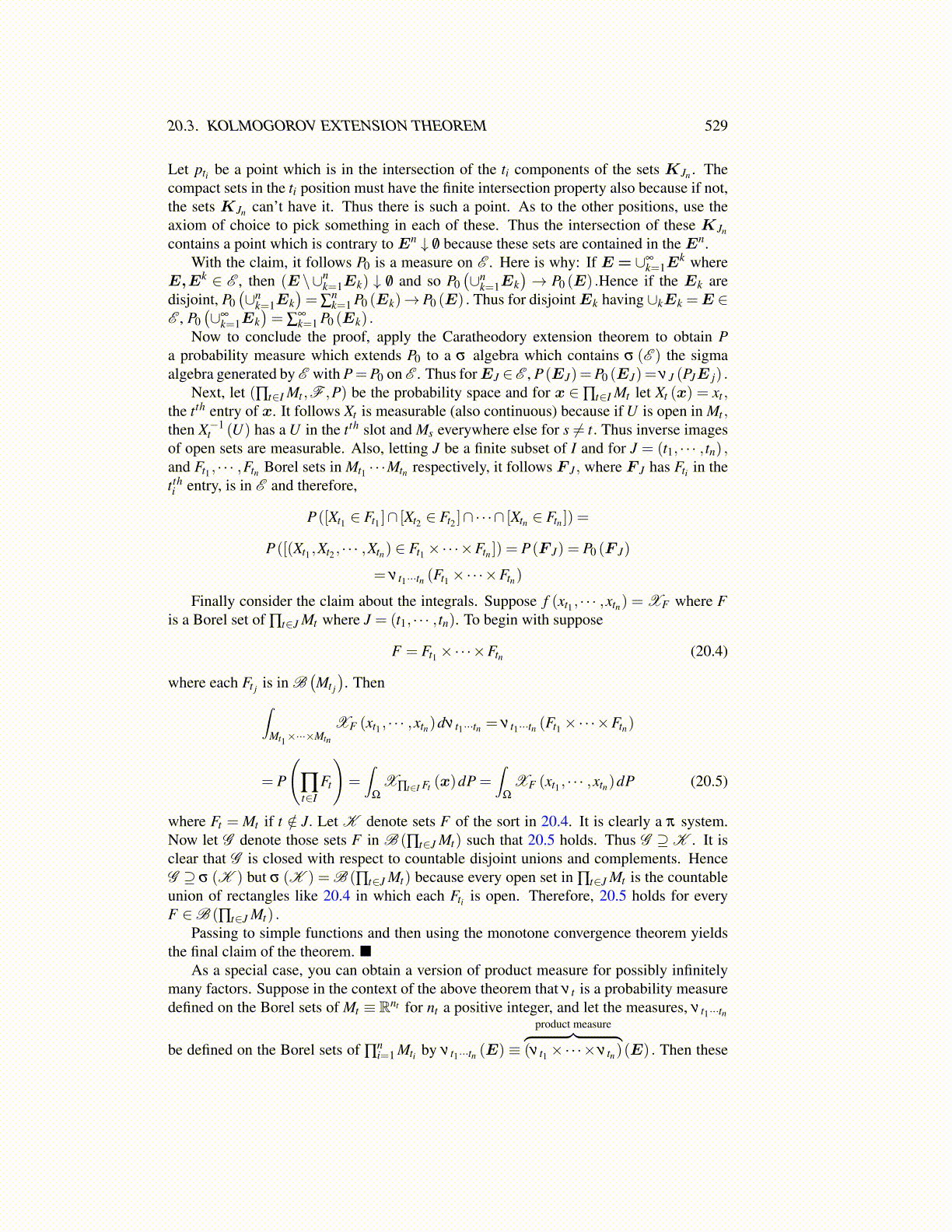
20.3. KOLMOGOROV EXTENSION THEOREM 529
Let pti be a point which is in the intersection of the ti components of the sets KJn . Thecompact sets in the ti position must have the finite intersection property also because if not,the sets KJn can’t have it. Thus there is such a point. As to the other positions, use theaxiom of choice to pick something in each of these. Thus the intersection of these KJn
contains a point which is contrary to En ↓ /0 because these sets are contained in the En.With the claim, it follows P0 is a measure on E . Here is why: If E = ∪∞
k=1Ek where
E,Ek ∈ E , then (E \∪nk=1Ek) ↓ /0 and so P0
(∪n
k=1Ek)→ P0 (E) .Hence if the Ek are
disjoint, P0(∪n
k=1Ek)= ∑
nk=1 P0 (Ek)→ P0 (E) . Thus for disjointEk having ∪kEk =E ∈
E , P0(∪∞
k=1Ek)= ∑
∞k=1 P0 (Ek) .
Now to conclude the proof, apply the Caratheodory extension theorem to obtain Pa probability measure which extends P0 to a σ algebra which contains σ (E ) the sigmaalgebra generated by E with P=P0 on E . Thus forEJ ∈E , P(EJ)=P0 (EJ)= νJ (PJE j) .
Next, let (∏t∈I Mt ,F ,P) be the probability space and for x ∈∏t∈I Mt let Xt (x) = xt ,the tth entry of x. It follows Xt is measurable (also continuous) because if U is open in Mt ,then X−1
t (U) has a U in the tth slot and Ms everywhere else for s ̸= t. Thus inverse imagesof open sets are measurable. Also, letting J be a finite subset of I and for J = (t1, · · · , tn) ,and Ft1 , · · · ,Ftn Borel sets in Mt1 · · ·Mtn respectively, it follows F J , where F J has Fti in thetthi entry, is in E and therefore,
P([Xt1 ∈ Ft1 ]∩ [Xt2 ∈ Ft2 ]∩·· ·∩ [Xtn ∈ Ftn ]) =
P([(Xt1 ,Xt2 , · · · ,Xtn) ∈ Ft1 ×·· ·×Ftn ]) = P(F J) = P0 (F J)
= ν t1···tn (Ft1 ×·· ·×Ftn)
Finally consider the claim about the integrals. Suppose f (xt1 , · · · ,xtn) = XF where Fis a Borel set of ∏t∈J Mt where J = (t1, · · · , tn). To begin with suppose
F = Ft1 ×·· ·×Ftn (20.4)
where each Ft j is in B(Mt j
). Then∫
Mt1×···×Mtn
XF (xt1 , · · · ,xtn)dν t1···tn = ν t1···tn (Ft1 ×·· ·×Ftn)
= P
(∏t∈I
Ft
)=∫
Ω
X∏t∈I Ft (x)dP =∫
Ω
XF (xt1 , · · · ,xtn)dP (20.5)
where Ft = Mt if t /∈ J. Let K denote sets F of the sort in 20.4. It is clearly a π system.Now let G denote those sets F in B (∏t∈J Mt) such that 20.5 holds. Thus G ⊇K . It isclear that G is closed with respect to countable disjoint unions and complements. HenceG ⊇ σ (K ) but σ (K ) = B (∏t∈J Mt) because every open set in ∏t∈J Mt is the countableunion of rectangles like 20.4 in which each Fti is open. Therefore, 20.5 holds for everyF ∈B (∏t∈J Mt) .
Passing to simple functions and then using the monotone convergence theorem yieldsthe final claim of the theorem. ■
As a special case, you can obtain a version of product measure for possibly infinitelymany factors. Suppose in the context of the above theorem that ν t is a probability measuredefined on the Borel sets of Mt ≡ Rnt for nt a positive integer, and let the measures, ν t1···tn
be defined on the Borel sets of ∏ni=1 Mti by ν t1···tn (E) ≡
product measure︷ ︸︸ ︷(ν t1 ×·· ·×ν tn)(E) . Then these